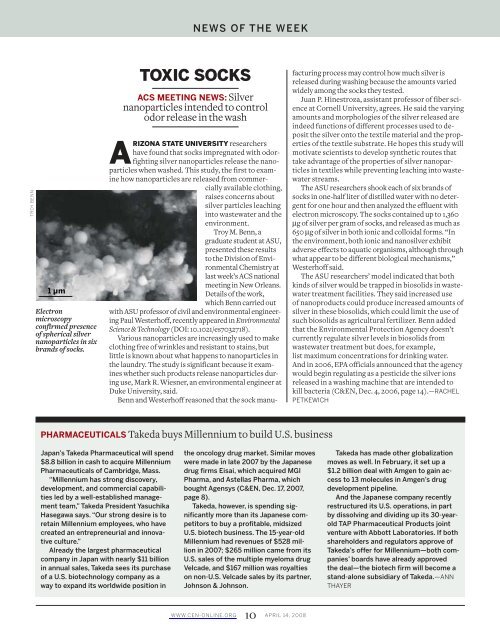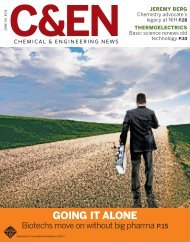Chemical & Engineering News Digital Edition - Institute of Materia ...
Chemical & Engineering News Digital Edition - Institute of Materia ...
Chemical & Engineering News Digital Edition - Institute of Materia ...
You also want an ePaper? Increase the reach of your titles
YUMPU automatically turns print PDFs into web optimized ePapers that Google loves.
TROY BENN<br />
Electron<br />
microscopy<br />
confirmed presence<br />
<strong>of</strong> spherical silver<br />
nanoparticles in six<br />
brands <strong>of</strong> socks.<br />
Japan’s Takeda Pharmaceutical will spend<br />
$8.8 billion in cash to acquire Millennium<br />
Pharmaceuticals <strong>of</strong> Cambridge, Mass.<br />
“Millennium has strong discovery,<br />
development, and commercial capabilities<br />
led by a well-established management<br />
team,” Takeda President Yasuchika<br />
Hasegawa says. “Our strong desire is to<br />
retain Millennium employees, who have<br />
created an entrepreneurial and innovative<br />
culture.”<br />
Already the largest pharmaceutical<br />
company in Japan with nearly $11 billion<br />
in annual sales, Takeda sees its purchase<br />
<strong>of</strong> a U.S. biotechnology company as a<br />
way to expand its worldwide position in<br />
NEWS OF THE WEEK<br />
TOXIC SOCKS<br />
ACS MEETING NEWS: Silver<br />
nanoparticles intended to control<br />
odor release in the wash<br />
ARIZONA STATE UNIVERSITY researchers<br />
have found that socks impregnated with odorfighting<br />
silver nanoparticles release the nanoparticles<br />
when washed. This study, the first to examine<br />
how nanoparticles are released from commercially<br />
available clothing,<br />
raises concerns about<br />
silver particles leaching<br />
into wastewater and the<br />
environment.<br />
Troy M. Benn, a<br />
graduate student at ASU,<br />
presented these results<br />
to the Division <strong>of</strong> Environmental<br />
Chemistry at<br />
last week’s ACS national<br />
meeting in New Orleans.<br />
Details <strong>of</strong> the work,<br />
which Benn carried out<br />
with ASU pr<strong>of</strong>essor <strong>of</strong> civil and environmental engineering<br />
Paul Westerh<strong>of</strong>f, recently appeared in Environmental<br />
Science & Technology (DOI: 10.1021/es7032718).<br />
Various nanoparticles are increasingly used to make<br />
clothing free <strong>of</strong> wrinkles and resistant to stains, but<br />
little is known about what happens to nanoparticles in<br />
the laundry. The study is significant because it examines<br />
whether such products release nanoparticles during<br />
use, Mark R. Wiesner, an environmental engineer at<br />
Duke University, said.<br />
Benn and Westerh<strong>of</strong>f reasoned that the sock manu-<br />
PHARMACEUTICALS Takeda buys Millennium to build U.S. business<br />
the oncology drug market. Similar moves<br />
were made in late 2007 by the Japanese<br />
drug firms Eisai, which acquired MGI<br />
Pharma, and Astellas Pharma, which<br />
bought Agensys (C&EN, Dec. 17, 2007,<br />
page 8).<br />
Takeda, however, is spending significantly<br />
more than its Japanese competitors<br />
to buy a pr<strong>of</strong>itable, midsized<br />
U.S. biotech business. The 15-year-old<br />
Millennium had revenues <strong>of</strong> $528 million<br />
in 2007; $265 million came from its<br />
U.S. sales <strong>of</strong> the multiple myeloma drug<br />
Velcade, and $167 million was royalties<br />
on non-U.S. Velcade sales by its partner,<br />
Johnson & Johnson.<br />
WWW.CEN-ONLINE.ORG 10 APRIL 14, 2008<br />
facturing process may control how much silver is<br />
released during washing because the amounts varied<br />
widely among the socks they tested.<br />
Juan P. Hinestroza, assistant pr<strong>of</strong>essor <strong>of</strong> fiber science<br />
at Cornell University, agrees. He said the varying<br />
amounts and morphologies <strong>of</strong> the silver released are<br />
indeed functions <strong>of</strong> different processes used to deposit<br />
the silver onto the textile material and the properties<br />
<strong>of</strong> the textile substrate. He hopes this study will<br />
motivate scientists to develop synthetic routes that<br />
take advantage <strong>of</strong> the properties <strong>of</strong> silver nanoparticles<br />
in textiles while preventing leaching into wastewater<br />
streams.<br />
The ASU researchers shook each <strong>of</strong> six brands <strong>of</strong><br />
socks in one-half liter <strong>of</strong> distilled water with no detergent<br />
for one hour and then analyzed the effluent with<br />
electron microscopy. The socks contained up to 1,360<br />
μg <strong>of</strong> silver per gram <strong>of</strong> socks, and released as much as<br />
650 μg <strong>of</strong> silver in both ionic and colloidal forms. “In<br />
the environment, both ionic and nanosilver exhibit<br />
adverse effects to aquatic organisms, although through<br />
what appear to be different biological mechanisms,”<br />
Westerh<strong>of</strong>f said.<br />
The ASU researchers’ model indicated that both<br />
kinds <strong>of</strong> silver would be trapped in biosolids in wastewater<br />
treatment facilities. They said increased use<br />
<strong>of</strong> nanoproducts could produce increased amounts <strong>of</strong><br />
silver in these biosolids, which could limit the use <strong>of</strong><br />
such biosolids as agricultural fertilizer. Benn added<br />
that the Environmental Protection Agency doesn’t<br />
currently regulate silver levels in biosolids from<br />
wastewater treatment but does, for example,<br />
list maximum concentrations for drinking water.<br />
And in 2006, EPA <strong>of</strong>ficials announced that the agency<br />
would begin regulating as a pesticide the silver ions<br />
released in a washing machine that are intended to<br />
kill bacteria (C&EN, Dec. 4, 2006, page 14).—RACHEL<br />
PETKEWICH<br />
Takeda has made other globalization<br />
moves as well. In February, it set up a<br />
$1.2 billion deal with Amgen to gain access<br />
to 13 molecules in Amgen’s drug<br />
development pipeline.<br />
And the Japanese company recently<br />
restructured its U.S. operations, in part<br />
by dissolving and dividing up its 30-yearold<br />
TAP Pharmaceutical Products joint<br />
venture with Abbott Laboratories. If both<br />
shareholders and regulators approve <strong>of</strong><br />
Takeda’s <strong>of</strong>fer for Millennium—both companies’<br />
boards have already approved<br />
the deal—the biotech firm will become a<br />
stand-alone subsidiary <strong>of</strong> Takeda.—ANN<br />
THAYER

















